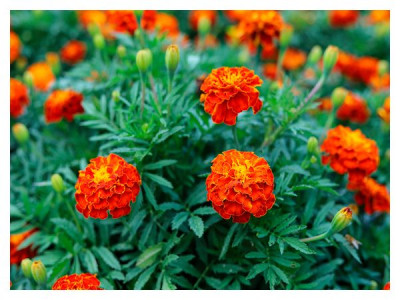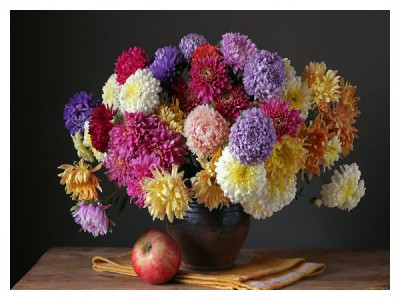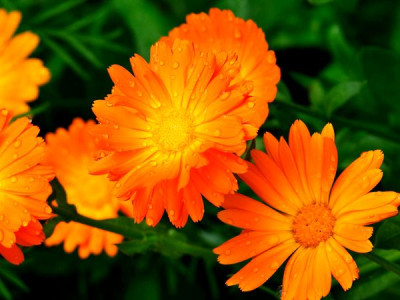Don't know how to plant and grow dahlias? Our article will help you get attractive flowers in your own flower garden. This fast-growing crop is ideal for beginners because it doesn't require any special skills to care for.
In the second half of summer, dahlia bushes are strewn with rather voluminous flowers of various colors and shapes. But to get lush flowering, they need to be planted in a sunny area well protected from the wind. Remember: dahlias must be exposed to light for at least 6 hours a day.

It is better for a novice gardener to buy sprouted dahlia tubers and plant them in well-warmed soil. In the middle zone, this time usually falls in the first ten days of June. Then, with proper care, the plants will take root well and will soon delight you with lush flowering.
When purchasing planting material, keep in mind that depending on the variety and age, the tubers may vary in size, but they should all be dense, elastic, not dry, with a small last year’s stem extending into the root collar.
How to grow dahlias from seeds?

This is a more troublesome option for growing dahlias, but less expensive. Experienced gardeners sow seeds in a container with light, moist soil (a mixture of humus, compost and calcined sand or perlite, taken in equal parts), lightly sprinkle with a thin layer of soil and cover with a transparent plastic lid or cling film. The container is placed in a lighted room with an air temperature of about 25°C.
The soil is moistened with a spray bottle as it dries. After 3-4 true leaves appear, the seedlings dive into separate cups, which are filled with disinfected soil (spilled with potassium permanganate). The plants are kept in a warm (about 20°C) and well-lit place, watered moderately, and when the seedlings become stronger, they are planted in a flowerbed in the summer.
How to grow dahlias from tubers?

It is recommended to prepare overwintered tubers for the upcoming season in advance. In April, they are taken out of storage, cleaned of dry roots, all rotten, damaged and dead parts are removed, and the cut areas are sprinkled with ash. Large dahlia tubers are divided into parts so that each of them has one bud with a root collar.
The cuttings are planted in containers with peat or any fertile soil so that the planting material is 1/3 buried. The container with tubers is placed in a well-lit place with an air temperature of 18-20°C, periodically and rather sparingly watered and ventilated in hot weather.
The sprouted tubers are planted in a previously prepared area along with a lump of earth to a depth of 6-8 cm. After which they are watered abundantly and lightly hilled.
The laziest gardeners will probably want to know how to plant dahlias without germination. Yes, very simple! Keep the tubers in a weak solution of potassium permanganate for half an hour, then place them in holes measuring 40x40x40 cm and sprinkle with fertile soil (humus-rich loams are suitable) so that the root collar is 2-3 cm below the ground level.
We create comfortable conditions for dahlias
When planting dahlias, for good growth, you need to put rotted manure, 20 g of superphosphate, 20 g of complex mineral fertilizer, a handful of lime and ash on the bottom of the hole and mix thoroughly with the soil. Plant tubers of medium- and tall-growing plants at a distance of 70-90 cm from each other; for low-growing plants, an interval of 45-60 cm is sufficient, and for dwarf plants – 20-30 cm.
In addition, when planting tall varieties of dahlias, you need to install pegs 120-160 cm high and tie the stems to them.
Caring for dahlias

In the first months (during active growth), dahlias are regularly watered, weeded and fed. 10-14 days after planting the plants in the ground, they are watered with slurry at the rate of 10 liters of fertilizer per 5 bushes.
In the first half of summer, you can re-fertilize with any nitrogen fertilizer, but from August only phosphorus and potassium are used. These macroelements will help the tubers survive better in winter. At the end of August - beginning of September, dahlia bushes are hilled to a height of 25 cm to protect the root collar from the first frosts.
Dahlias bloom 30-70 days after planting. Lush flowers decorate the garden from about mid-July until frost. At the same time, low-growing plants bloom earlier and are less demanding in care, while medium- and tall-growing specimens are more powerful, so their growth needs to be regulated: periodically in the morning remove stepsons and excess leaves, pinch out buds and form bushes of 1-3 stems.
Difficulties you may encounter when growing dahlias

Lack of proper formation is the most common reason why dahlias do not bloom. But if growing conditions are unsuitable, other problems may arise. For example, yellowing of the lower leaves and the formation of spotting.
Most often, these ailments appear as a result of a lack of nutrients (they are replenished with the help of fertilizing) and growing flowers in soil with an inappropriate pH. Please note: dahlias prefer slightly acidic soil.
Dahlia bushes are sensitive to excess moisture, especially at the beginning of the growing season. Their suction roots die and the tubers rot. To restore the root system of plants, they are watered with water containing a root formation stimulator (Kornevin, Heteroauxin).
Pests of dahlias

The greatest damage to dahlias is caused by aphids, various beetles, their larvae and caterpillars, thrips, snails and spider mites.
During drought, they are especially numerous and harmful because they carry a disease that is dangerous for dahlias - viral mosaic.
To protect plants from pests, destroy weeds and plant debris in a timely manner, dig up the soil in the fall and, if insects are found, spray dahlias with Actellik, Bi-58, Nurell-D, Inta-Vir, infusions of yarrow (8%), onion peel (half a bucket of peel fill with water to the brim and leave for a day). To prevent pests from becoming accustomed to certain active ingredients, the drugs must be alternated.
The tubers and roots of dahlias are often gnawed by the larvae of wireworms and beetles. To “evict” pests from a site, it is necessary to regularly loosen the soil between the bushes, while manually selecting and destroying the larvae. When preparing the soil for planting, you can add drugs to it against a complex of soil pests. It’s also good to sow marigolds between the rows.










Write a comment